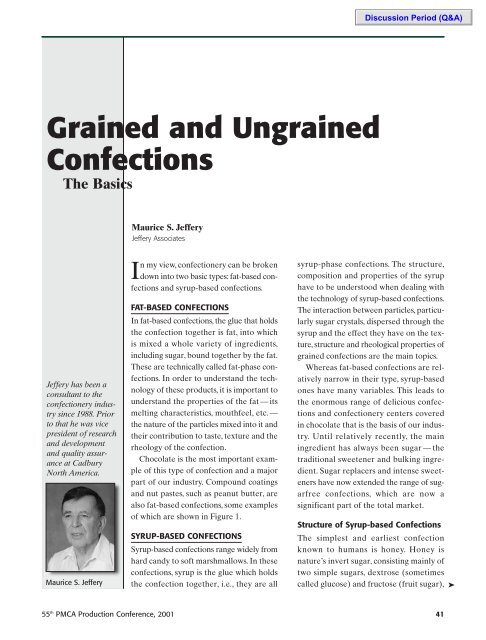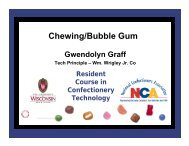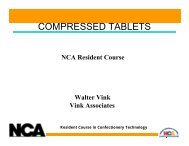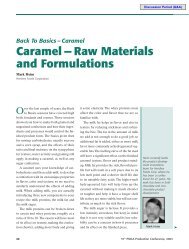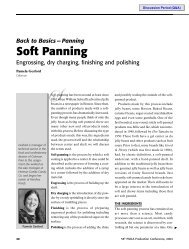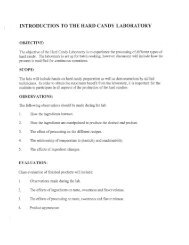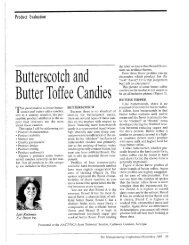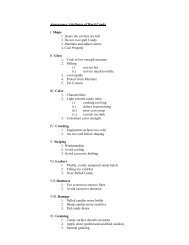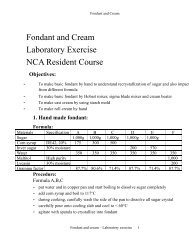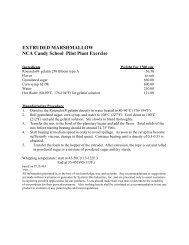2001 Grained and Ungrained Confections - staging.files.cms.plus.com
2001 Grained and Ungrained Confections - staging.files.cms.plus.com
2001 Grained and Ungrained Confections - staging.files.cms.plus.com
You also want an ePaper? Increase the reach of your titles
YUMPU automatically turns print PDFs into web optimized ePapers that Google loves.
<strong>Grained</strong> <strong>and</strong> <strong>Ungrained</strong><br />
<strong>Confections</strong><br />
The Basics<br />
Jeffery has been a<br />
consultant to the<br />
confectionery industry<br />
since 1988. Prior<br />
to that he was vice<br />
president of research<br />
<strong>and</strong> development<br />
<strong>and</strong> quality assurance<br />
at Cadbury<br />
North America.<br />
Maurice S. Jeffery<br />
Maurice S. Jeffery<br />
Jeffery Associates<br />
In my view, confectionery can be broken<br />
down into two basic types: fat-based confections<br />
<strong>and</strong> syrup-based confections.<br />
FAT-BASED CONFECTIONS<br />
In fat-based confections, the glue that holds<br />
the confection together is fat, into which<br />
is mixed a whole variety of ingredients,<br />
including sugar, bound together by the fat.<br />
These are technically called fat-phase confections.<br />
In order to underst<strong>and</strong> the technology<br />
of these products, it is important to<br />
underst<strong>and</strong> the properties of the fat — its<br />
melting characteristics, mouthfeel, etc. —<br />
the nature of the particles mixed into it <strong>and</strong><br />
their contribution to taste, texture <strong>and</strong> the<br />
rheology of the confection.<br />
Chocolate is the most important example<br />
of this type of confection <strong>and</strong> a major<br />
part of our industry. Compound coatings<br />
<strong>and</strong> nut pastes, such as peanut butter, are<br />
also fat-based confections, some examples<br />
of which are shown in Figure 1.<br />
SYRUP-BASED CONFECTIONS<br />
Syrup-based confections range widely from<br />
hard c<strong>and</strong>y to soft marshmallows. In these<br />
confections, syrup is the glue which holds<br />
the confection together, i.e., they are all<br />
syrup-phase confections. The structure,<br />
<strong>com</strong>position <strong>and</strong> properties of the syrup<br />
have to be understood when dealing with<br />
the technology of syrup-based confections.<br />
The interaction between particles, particularly<br />
sugar crystals, dispersed through the<br />
syrup <strong>and</strong> the effect they have on the texture,<br />
structure <strong>and</strong> rheological properties of<br />
grained confections are the main topics.<br />
Whereas fat-based confections are relatively<br />
narrow in their type, syrup-based<br />
ones have many variables. This leads to<br />
the enormous range of delicious confections<br />
<strong>and</strong> confectionery centers covered<br />
in chocolate that is the basis of our industry.<br />
Until relatively recently, the main<br />
ingredient has always been sugar — the<br />
traditional sweetener <strong>and</strong> bulking ingredient.<br />
Sugar replacers <strong>and</strong> intense sweeteners<br />
have now extended the range of sugarfree<br />
confections, which are now a<br />
significant part of the total market.<br />
Structure of Syrup-based <strong>Confections</strong><br />
The simplest <strong>and</strong> earliest confection<br />
known to humans is honey. Honey is<br />
nature’s invert sugar, consisting mainly of<br />
two simple sugars, dextrose (sometimes<br />
called glucose) <strong>and</strong> fructose (fruit sugar), ➤<br />
55 th PMCA Production Conference, <strong>2001</strong> 41
<strong>Grained</strong> <strong>and</strong> <strong>Ungrained</strong> <strong>Confections</strong><br />
In hard c<strong>and</strong>y the<br />
viscosity of the<br />
syrup is so high<br />
that the sugar<br />
molecules in it<br />
cannot <strong>com</strong>e<br />
together to<br />
form crystals.<br />
Examples of Fat-based <strong>Confections</strong><br />
Figure 1<br />
Examples of Fondants <strong>and</strong> Cremes<br />
Figure 2<br />
Examples of Hard C<strong>and</strong>y<br />
Figure 3<br />
dissolved in water to form the familiar,<br />
deliciously sweet syrup.<br />
Honey is normally a clear liquid with a<br />
pale amber color, but sometimes honey<br />
be<strong>com</strong>es opaque. It changes in character<br />
from a free-flowing liquid to a paste, sometimes<br />
called honey butter.The least soluble<br />
of the sugars in honey butter, dextrose, has<br />
crystallized because its solubility in water<br />
is only 48 percent at 70°F, <strong>com</strong>pared with<br />
fructose (79.3% at 70°F), <strong>and</strong> the syrup is<br />
said to have grained.The dextrose crystals<br />
reflect light, so that the syrup be<strong>com</strong>es<br />
opaque.They also have a large surface area<br />
which has to be lubricated by the remaining<br />
syrup still holding the structure<br />
together, so that the grained product does<br />
not readily flow.<br />
There are fundamental differences<br />
between syrup-based confections with<br />
uncrystallized syrup holding or gluing the<br />
confection together <strong>and</strong> those in which one<br />
or more of the ingredients dissolved in the<br />
syrup have crystallized, changing its character<br />
in several ways.This simple example<br />
demonstrates clearly the change in physical<br />
character from a thermoplastic material<br />
that will flow, to one with internal friction<br />
between crystallized particles that<br />
inhibits flow.<br />
Honey butter is the earliest example of<br />
a fondant — a dextrose fondant.We will be<br />
examining sugar versions of this <strong>and</strong> discussing<br />
the technology of fondants <strong>and</strong><br />
cremes, examples of which are shown in<br />
Figure 2.<br />
We can also change the character of a<br />
syrup by taking some of the water out of it.<br />
As we do so, it be<strong>com</strong>es more <strong>and</strong> more<br />
viscous. Finally, when we reduce the water<br />
below 3–4 percent, the syrup be<strong>com</strong>es so<br />
viscous that when it is cooled it forms a<br />
glass-like product, forming the basis of the<br />
hard c<strong>and</strong>y section of our industry. In hard<br />
c<strong>and</strong>y, the viscosity of the syrup is so high<br />
that the sugar molecules in it cannot <strong>com</strong>e<br />
together to form crystals, <strong>and</strong> it has thermoplastic<br />
characteristics — glass-like when<br />
cold <strong>and</strong> softening when warmed. If we<br />
warm it enough to agitate or mix it, some<br />
sugar microcrystallization can take place,<br />
<strong>and</strong> we use this in pulled-sugar products<br />
to change the texture <strong>and</strong> appearance of<br />
the hard c<strong>and</strong>y, examples of which are<br />
shown in Figure 3.<br />
➤<br />
42 55 th PMCA Production Conference, <strong>2001</strong>
If we take a simple syrup, add air <strong>and</strong> a<br />
protein material — a whipping agent — to<br />
help air mix into it, numerous small bubbles<br />
are formed, which weaken the syrup glue.<br />
Its density is also decreased <strong>and</strong> at the same<br />
time it be<strong>com</strong>es opaque, because the air bubbles<br />
reflect light.This gives us marshmallow<br />
confections. We can also cause some of the<br />
sugar in the syrup to crystallize, further weakening<br />
the syrup <strong>and</strong> changing its texture, producing<br />
grained marshmallows, examples of<br />
which are shown in Figure 4.<br />
We can also take this whipped syrup,<br />
uncrystallized or crystallized, add fat <strong>and</strong><br />
flavoring ingredients (such as cocoa powder)<br />
to produce the ever-popular nougats<br />
or nougatines. These vary in texture from<br />
hard torrone to the soft nougats that make<br />
up a major part of bar lines — Snickers,<br />
Milky Way, Baby Ruth <strong>and</strong> many other<br />
products, as shown in Figure 5.<br />
When we add milk to the syrup <strong>and</strong> cook<br />
it, characteristic flavors are produced. Milk<br />
protein <strong>and</strong> reducing sugars (such as dextrose,<br />
maltose or fructose), along with the<br />
sugar in the milk (lactose), react together<br />
via the Mailliard reaction to produce the<br />
flavor of caramel confections.<br />
When the syrup is made to crystallize to<br />
break up its structure, the texture be<strong>com</strong>es<br />
short <strong>and</strong> less chewy, leading to the whole<br />
range of fudges. Their texture varies with<br />
the amount of crystallization of the syrup,<br />
ranging from a grained caramel with sufficient<br />
crystallization to give the product<br />
good st<strong>and</strong>-up properties <strong>and</strong> machinability,<br />
to heavily grained hard fudge. Examples<br />
of caramel <strong>and</strong> fudge products are<br />
shown in Figure 6.<br />
Finally, if we add a gelling agent (such<br />
as gelatin, starch, pectin, etc.) the syrup is<br />
changed from one that flows to one that is<br />
immobilized in a gel structure. The resulting<br />
texture depends mainly on the gelling<br />
agent used.<br />
The molecules of sugar are effectively<br />
<strong>Grained</strong> <strong>and</strong> <strong>Ungrained</strong> <strong>Confections</strong><br />
Examples of Marshmallows<br />
Figure 4<br />
Examples of Nougats <strong>and</strong> Taffy<br />
Figure 5<br />
Examples of Caramels <strong>and</strong> Fudges<br />
Figure 6<br />
55 th PMCA Production Conference, <strong>2001</strong> 43<br />
➤
<strong>Grained</strong> <strong>and</strong> <strong>Ungrained</strong> <strong>Confections</strong><br />
Controlling the<br />
water content in<br />
finished products,<br />
both in their<br />
manufacture <strong>and</strong><br />
on their way to<br />
the consumer, is<br />
essential for<br />
consistent quality.<br />
Examples of Jellies<br />
Figure 7<br />
locked in place <strong>and</strong> cannot move around<br />
freely or <strong>com</strong>e together to crystallize.These<br />
jellies remain uncrystallized gelatinized<br />
syrups <strong>and</strong> not grained ones.This produces<br />
the wide range of jelly confections which<br />
are another major part of our business,<br />
examples of which are shown in Figure 7.<br />
Faced with this wide variety of syrupbased<br />
confections, it is important to pick<br />
out items which are <strong>com</strong>mon to all of them<br />
before exploring the technology of those<br />
in which sugar crystals break up the syrup<br />
glue that binds their structures together.<br />
Common Features<br />
Syrup-based confections all contain water.<br />
For the same recipe, the higher the water<br />
content, the softer the confection. Controlling<br />
the water content in finished products,<br />
both in their manufacture <strong>and</strong> on their<br />
way to the consumer, is essential for consistent<br />
quality.This requires that we properly<br />
formulate, process, protectively pack<br />
<strong>and</strong> distribute to achieve this goal.<br />
For a normal shelf life of 6–9 months,<br />
these products must have an equilibrium<br />
relative humidity of less then 65 percent.<br />
This translates into a water activity of<br />
below 0.65. Water activity is a measure of<br />
how available the water is to bacteria,<br />
yeasts <strong>and</strong> molds to allow them to be active<br />
<strong>and</strong> propagate. It can be measured by a<br />
water activity meter. Pure water has a water<br />
activity of 1, but as we dissolve other materials<br />
in it (such as sugar, invert sugar <strong>and</strong><br />
particularly small molecules of such things<br />
as salt) the availability is reduced or locked<br />
up <strong>and</strong> the water activity falls. We cannot<br />
put enough salt into a confection without<br />
making it inedible to get down to 0.65, so<br />
we have to rely on sugar, corn syrup <strong>and</strong><br />
other materials (such as sorbitol, fructose,<br />
etc.) dissolved in the water to reduce the<br />
water activity down to a safe level. To do<br />
this, a total of at least 76–78 percent of<br />
these materials must be dissolved in the<br />
water (the soluble solids) to form the syrup<br />
which binds the confection together.<br />
Water activity is often confused with<br />
moisture content <strong>and</strong> total solids in the<br />
confection, but it is only those solids which<br />
are dissolved in the water that reduce<br />
water activity.<br />
This is why it is important to know the<br />
solubility of sugar (68% at 70°F), fructose<br />
(79.3% at 70°F) <strong>and</strong> corn syrup solids (82%<br />
at 70°F generally) in formulating stable<br />
confections.As you can see, it is not possible<br />
to produce a shelf-stable syrup-based<br />
confection from sugar alone. This is why<br />
we generally use corn syrup <strong>and</strong> other more<br />
soluble sugars in confectionery recipes.<br />
This is very important to underst<strong>and</strong> as<br />
we move on to confections where we deliberately<br />
make sugar crystallize from the<br />
syrup binding the confections together,<br />
reducing its soluble solids. We must formulate<br />
the recipes to end up with sufficient<br />
soluble solids left in the water, after crystallization<br />
has taken place, to keep the<br />
water activity below 0.65, to produce a stable,<br />
grained confection.<br />
CRYSTALLIZATION OF SYRUPS<br />
Before reviewing specific ungrained <strong>and</strong><br />
grained confections <strong>and</strong> their recipes <strong>and</strong><br />
manufacturing processes, it is important to<br />
examine the key factors that affect the crystallization<br />
of syrups.<br />
➤<br />
44 55 th PMCA Production Conference, <strong>2001</strong>
Concentration<br />
The concentration of each of the ingredients<br />
in the syrup <strong>and</strong> its solubility in water<br />
at room temperature must be known. If<br />
any of them are more concentrated than<br />
their solubility, they potentially can crystallize<br />
to precipitate the excess, leaving the<br />
syrup saturated with the ingredient.<br />
Although the ingredient potentially can<br />
crystallize, it may not if its molecules cannot<br />
<strong>com</strong>e together to form crystals because,<br />
for instance, a gelling agent prevents them<br />
from moving, or some of the other factors<br />
listed below are having a similar effect.<br />
The situation is <strong>com</strong>plicated by the interactions<br />
between all of the ingredients, all<br />
<strong>com</strong>peting for the water in the syrup.Thus<br />
it is their mixed solubility which is important<br />
to know in evaluating their ability to<br />
crystallize.<br />
For most of the grained confections we<br />
will discuss, sugar is the ingredient which<br />
crystallizes from the syrup binding the confection<br />
together, leaving up to 68 percent<br />
sugar, at room temperature, still in solution<br />
to help stabilize the product.<br />
Viscosity of the Syrup<br />
Gelling agents effectively immobilize the<br />
sugar molecules in jellies <strong>and</strong> prevent sugar<br />
crystallization from taking place.Other ingredients,<br />
particularly the long chain dextrins<br />
in corn syrup, increase the viscosity of a<br />
syrup. The higher their concentration the<br />
more viscous the syrup be<strong>com</strong>es <strong>and</strong> the<br />
more difficult for crystallization to take place.<br />
The extreme effect of viscosity is shown<br />
in hard c<strong>and</strong>y where the moisture content<br />
is so low (2–3%) that the sugar in the<br />
recipe should crystallize, but the viscosity of<br />
the sugar glass is so high that it cannot.<br />
However, when st<strong>and</strong>ard hard c<strong>and</strong>y is<br />
left unwrapped, it picks up moisture from<br />
the atmosphere. The syrup formed on the<br />
surface is lower in viscosity <strong>and</strong> sugar crys-<br />
<strong>Grained</strong> <strong>and</strong> <strong>Ungrained</strong> <strong>Confections</strong><br />
tals can form to give a grained skin on the<br />
product. If the dextrin content of the recipe<br />
is high enough by using, for instance, a<br />
recipe with 50 percent low 36 de corn<br />
syrup in it, surface graining may not take<br />
place but the surface gets sticky.<br />
Viscosity is also affected by temperature.<br />
It increases as the temperature is lowered.<br />
If products are stored in cold rooms or in<br />
freezers, crystallization can be inhibited<br />
even though the solubility of sugar is<br />
reduced as the temperature is lowered. It is<br />
like gold fish in a fish bowl.When the water<br />
is at room temperature, the fish can swim<br />
around happily <strong>and</strong> collect together, but<br />
when the bowl is put in a freezer, the fish<br />
are locked in ice <strong>and</strong> cannot move. If we<br />
think of the sugar molecules in a syrup as<br />
the fish, you can visualize the effect of temperature<br />
on crystallization.<br />
Seeding of the Syrup<br />
Crystallization is made easier when the<br />
sugar molecules are given a pattern to follow<br />
in forming crystals. If sugar crystals are<br />
mixed into the syrup, crystallization is initiated.The<br />
more that are added, the greater<br />
the chance of graining taking place. This is<br />
similar to seeding chocolate by tempering<br />
to provide a pattern for cocoa butter to crystallize.<br />
Seeding with fine sugar crystals, in<br />
the form of fondant, is an important part of<br />
grained-confections technology.<br />
Mixing<br />
Crystallization of a syrup is helped considerably<br />
by agitation or mixing it to assist<br />
the sugar molecules to <strong>com</strong>e together to<br />
form crystals. Generally the more vigorous<br />
the mixing, the faster the syrup will grain<br />
<strong>and</strong> the smaller the sugar crystals which<br />
form. Slow crystallization generally produces<br />
large crystals.<br />
Cooling <strong>and</strong> Temperature<br />
When sugar crystallizes from a syrup it ➤<br />
It is not possible<br />
to produce a shelfstable<br />
syrup-based<br />
confection from<br />
sugar alone.<br />
55 th PMCA Production Conference, <strong>2001</strong> 45
<strong>Grained</strong> <strong>and</strong> <strong>Ungrained</strong> <strong>Confections</strong><br />
The higher the<br />
sugar content of<br />
fondant, the<br />
higher the water<br />
activity, with the<br />
greater danger of<br />
mold growth<br />
<strong>and</strong> yeast<br />
fermentation.<br />
gives out heat. If this is not removed by<br />
cooling, the syrup temperature will rise,<br />
affecting the crystal size <strong>and</strong> amount of<br />
crystals formed. Generally the higher the<br />
crystallization temperature the larger the<br />
sugar crystals which are formed.<br />
This leads us to specific grained confections,<br />
which hopefully will reinforce these<br />
general factors.<br />
FONDANTS AND CREMES<br />
Fondants are the simplest of grained confections.They<br />
are normally based on sugar,<br />
although sugarfree ones based on maltitol or<br />
other polyols are being made.Their structure<br />
consists of sugar crystals dispersed in a saturated<br />
solution of sugar <strong>and</strong> other carbohydrates<br />
such as invert sugar <strong>and</strong> corn syrup.<br />
Those other carbohydrates are sometimes<br />
essential to the shelf stability of the product.<br />
Normally there is 50–60 percent sugar<br />
crystals dispersed in 40–50 percent syrup.<br />
Fondant recipes consist of three main<br />
ingredients: sugar, water <strong>and</strong> corn syrup.<br />
These are <strong>com</strong>bined with other ingredients<br />
such as invert sugar, fructose, sorbitol <strong>and</strong><br />
glycerol. Sometimes mold-inhibiting chemicals,<br />
such as sorbic acid, are added where a<br />
formulation gives a product with a water<br />
activity greater than 0.65.You can avoid this<br />
by using the correct formulation, if possible.<br />
Even with this simple recipe, there are<br />
many variables.<br />
Moisture Content<br />
The water content of the finished fondant<br />
is the most critical variable, because<br />
it affects the efficiency of using it, <strong>and</strong> its<br />
shelf life. Generally water content is in<br />
the range of 12–15 percent but should be<br />
controlled accurately, i.e., within ± 1 ⁄2 percent<br />
of that specified.<br />
Type of Corn Syrup<br />
Corn syrups now cover a wide range of <strong>com</strong>positions.<br />
The major <strong>com</strong>ponents are dex-<br />
trose, maltose <strong>and</strong> dextrins — mainly consisting<br />
of long molecular chains of dextrose.<br />
The quantity of dextrose <strong>plus</strong> maltose<br />
on a dry solids basis is expressed as dextrose<br />
equivalent (de). Now that enzymes<br />
are also used to produce corn syrup, it is<br />
possible to change the ratio of dextrose to<br />
maltose <strong>and</strong> achieve higher de. High-maltose<br />
<strong>and</strong> high-dextrose corn syrups can also<br />
be produced. In addition, it is possible to<br />
produce high-fructose syrups, which are<br />
sweeter.These are increasingly used in confectionery,<br />
although mainly in the beverage<br />
industry.<br />
High-de syrups have less dextrins in<br />
them; they are particularly important in<br />
fondants because they affect the viscosity<br />
<strong>and</strong> the crystallization of sugar from the<br />
fondant syrup. Low-de corn syrups lead<br />
to more viscous fondant syrups with slower<br />
crystallization of sugar from them, <strong>and</strong><br />
high-de corn syrups do the opposite. The<br />
choice of corn syrup therefore is a very<br />
important variable.<br />
Amount of Sugar<br />
The sugar content of the recipe,which<br />
increases the ratio of sugar to corn syrup,<br />
is a key variable.The higher the sugar content<br />
the more sugar crystals are formed<br />
<strong>and</strong> the harder the fondant, for a given<br />
water content.<br />
Amount of Other Materials<br />
The quantities of humectants, such as sorbitol,<br />
glycerol <strong>and</strong> invert sugar, are also<br />
important.They reduce the viscosity of the<br />
fondant syrup, increase sugar crystallization<br />
rates <strong>and</strong> lower water activity.<br />
Commercially available fondants are<br />
generally made to simple recipes, using<br />
sugar, water <strong>and</strong> 42 de acid-converted corn<br />
syrup. They are often referred to by the<br />
ratio of sugar to corn syrup, e.g., 8:1 fondant<br />
contains eight parts of sugar <strong>and</strong> one<br />
part of corn syrup.The soluble solids of the ➤<br />
46 55 th PMCA Production Conference, <strong>2001</strong>
syrup in the finished product are below 75<br />
percent. Because this recipe is unstable a<br />
small quantity of sorbic acid or potassium<br />
sorbate is added to inhibit mold growth.<br />
The higher the sugar content of fondant,<br />
the higher the water activity, with the<br />
greater danger of mold growth <strong>and</strong> yeast<br />
fermentation. This is why you sometimes<br />
find black spots of mold on the surface <strong>and</strong><br />
inside high-sugar fondants. This will not<br />
happen with a 3:2 fondant using st<strong>and</strong>ard<br />
42 de corn syrup.There are many ways of<br />
eliminating this using the newer corn syrups<br />
<strong>and</strong> incorporating ingredients that lower<br />
water activity, such as sorbitol or glycerol.<br />
Making Fondant<br />
Making fondant can be broken down into<br />
a number of steps as shown in Figure 8.<br />
Essentially, the cooking temperature controls<br />
the final moisture content of the fondant<br />
<strong>and</strong> must be controlled accurately,<br />
including <strong>com</strong>pensating for the effect of<br />
atmospheric pressure on the cooking temperature,<br />
cooking higher on dry days when<br />
the pressure is high <strong>and</strong> lower on wet days<br />
when the pressure is low.<br />
Figure 9 shows a typical cooking-temperature<br />
<strong>com</strong>pensation chart for a sugar<br />
syrup, indicating the cooking temperature<br />
required for a specific water content.<br />
The crystallization temperature <strong>and</strong> the<br />
mixing or shear rate control the size distribution<br />
of the sugar crystals. In general,<br />
the higher the syrup temperature when it is<br />
mixed to cause sugar to crystallize, the<br />
larger the crystals produced. Generally,<br />
also, the faster the syrup is mixed, the<br />
smaller the crystals.<br />
When you make fondant either by h<strong>and</strong><br />
or by machine, there is not just one size of<br />
sugar crystal produced but a whole range.<br />
The sugar crystals, in addition to sweetness,<br />
contribute texture <strong>and</strong> surface area,<br />
which considerably govern the viscosity of<br />
the fondant <strong>and</strong> affect its use. The human<br />
<strong>Grained</strong> <strong>and</strong> <strong>Ungrained</strong> <strong>Confections</strong><br />
Steps for the Manufacturing<br />
of Fondant<br />
Water<br />
Sugar<br />
Corn syrup<br />
Syrup making<br />
moisture content<br />
75–78%<br />
Cooking to<br />
control moisture<br />
content 12/14%<br />
Cooling<br />
115˚—190˚F<br />
High shear<br />
mixing to<br />
crystallize syrup<br />
To store or next<br />
process<br />
Figure 8<br />
Barometric Pressure<br />
Accurate recipe weighing.<br />
Proper dissolving of<br />
sugar before<br />
adding corn syrup.<br />
Cooking temperature<br />
<strong>com</strong>pensated for<br />
atmospheric pressure.<br />
Final moisture of syrup.<br />
Temperature cooled<br />
down to, without<br />
agitation or<br />
precrystallization.<br />
Crystallizing<br />
temperature.<br />
Flow of cooling water<br />
to keep this at required<br />
temperature.<br />
Mixing speed.<br />
Storage temperatures<br />
<strong>and</strong> RH<br />
(normally 100˚F <strong>and</strong><br />
65% RH)<br />
palette can only detect particles greater in<br />
size than 12–16 microns. Below this all particles<br />
taste smooth, just like water. Bigger<br />
particles control the detectable texture of<br />
the product. When they reach 50 microns<br />
<strong>and</strong> above, they start to be<strong>com</strong>e s<strong>and</strong>y <strong>and</strong><br />
too coarse to be pleasant. Generally, fon- ➤<br />
The human palette<br />
can only detect<br />
particles greater in<br />
size than 12–16<br />
microns, below this<br />
all particles taste<br />
smooth, just like<br />
water.<br />
in inches<br />
Moisture<br />
Content 29.42°F 29.67°F 29.92°F 30.17°F 30.42°F 30.67°F 30.92°F<br />
14% 236.5 236.8 237.2 237.6 238.2 238.5 239.0<br />
13% 238.8 239.1 239.5 240.0 240.5 240.8 241.3<br />
12% 240.8 241.2 241.5 242.0 242.4 242.8 243.4<br />
11% 243.1 243.5 244.0 244.4 244.8 245.8 246.2<br />
10% 245.8 246.2 246.6 247.0 247.5 248.0 248.5<br />
9% 248.6 249.0 249.5 250.0 250.5 251.0 251.4<br />
8.5%<br />
Figure 9<br />
250.1 250.5 251.0 251.5 251.9 252.4 252.8<br />
55 th PMCA Production Conference, <strong>2001</strong> 47
<strong>Grained</strong> <strong>and</strong> <strong>Ungrained</strong> <strong>Confections</strong><br />
Fondant can be<br />
made on a relatively<br />
small scale by batch<br />
methods using<br />
cooking kettles <strong>and</strong><br />
cooled batch mixers.<br />
dants intended for very smooth cremes have<br />
sugar crystals below 12 microns, but for<br />
some applications where coarser textures<br />
are desired they range up to 40–50 microns.<br />
Whatever texture is required, it is important<br />
to get a consistent particle size distribution<br />
because it affects the viscosity of<br />
the fondant when it is used for starch <strong>and</strong><br />
starchless moulding, particularly singleshot<br />
depositing, where viscosity control is<br />
critical. Sugar particle size also affects the<br />
setting rate of the deposited fondant or<br />
cremes in which it is used. This is particularly<br />
important in starchless moulded products<br />
where setting times, ready for<br />
demoulding, are 10–15 minutes, instead of<br />
the hours available in starch moulding.<br />
Controlling particle size distribution<br />
requires the following:<br />
• Accurate recipe control.<br />
• Accurate water content control.<br />
• Accurate control of crystallization temperature.<br />
• Consistent mixing speed/shear rate.<br />
To illustrate this, we are going to discuss<br />
fondant-making both by h<strong>and</strong> <strong>and</strong> by<br />
machine using three recipes, to illustrate<br />
the effect of recipe on crystallization rate<br />
<strong>and</strong> the effect of recipe on water activity.<br />
We will also show the effect of mixing rate<br />
on particle size distribution.<br />
Commercial Equipment<br />
Fondant can be made on a relatively small<br />
scale by batch methods using cooking kettles<br />
<strong>and</strong> cooled batch mixers to crystallize<br />
the syrup. The old ball beaters are still in<br />
operation doing this.<br />
On a larger scale continuous methods<br />
are used, consisting basically of four parts:<br />
• A recipe batching system to put<br />
together an uncooked 75 percent soluble<br />
solids syrup.<br />
• A cooker to boil the syrup to the correct<br />
moisture content.<br />
• A cooling drum or other means of cool-<br />
ing the syrup as a thin unagitated film to<br />
a controlled uniform temperature.<br />
• A water-cooled mixer to vigorously mix<br />
the cooled syrup to crystallize it <strong>and</strong><br />
remove the heat of crystallization given<br />
out as the sugar crystals are formed.<br />
There are many types of equipment for<br />
doing this.<br />
Accurate control of each stage for consistent<br />
product <strong>and</strong> efficient operation of<br />
this <strong>and</strong> subsequent processes is essential.<br />
Uses of Fondant<br />
Fondant is used in several ways:<br />
• For making starch or starchless moulded<br />
units, often flavored with peppermint or<br />
fruit flavors <strong>and</strong> sugar crusted to give a<br />
glistening appearance.<br />
• For making cremes, which are generally<br />
softer than fondants <strong>and</strong> used as centers<br />
for chocolate enrobing, or as fillings for<br />
shell-moulded or single-shot moulded<br />
products.<br />
• To control the crystallization of other<br />
confections, such as fudge or nougat, by<br />
adding it to seed their graining.<br />
Moulded Fondants<br />
Moulded fondants vary in texture from<br />
crisp, hard ones used for coating in sugar<br />
crystals to softer ones coated in chocolate.<br />
The final soft texture is made by adding<br />
the enzyme invertase to the recipe.<br />
Moulded fondants are made by reheating<br />
the base fondant to the required<br />
depositing temperature, generally 160°–<br />
170°F, <strong>and</strong> adding a thinning syrup to adjust<br />
its viscosity. A typical recipe is shown in<br />
Figure 10.<br />
The thinning syrup is similar in recipe<br />
to the fondant but has a higher moisture<br />
content, <strong>and</strong> often a humectant such as sorbitol<br />
added to it. The temperature of the<br />
mix is finally adjusted to the depositing<br />
temperature. Color is mixed in before the<br />
fondant is deposited into starch or starchless<br />
moulds. Starch-moulded fondants are<br />
left for 6–8 hours in a conditioned room ➤<br />
48 55 th PMCA Production Conference, <strong>2001</strong>
to cool <strong>and</strong> set before demoulding, ready<br />
for finishing.<br />
Starchless moulding requires some<br />
adjustment of the recipe <strong>and</strong> depositing<br />
temperature to enable the fondant syrup<br />
to be cooled <strong>and</strong> set in 5–10 minutes to<br />
demould efficiently. Generally the moisture<br />
content of the deposited fondant is 0.5<br />
percent lower than that used in starch<br />
moulding because no loss in moisture takes<br />
place in the starchless mould, as it does in<br />
starch. The depositing temperature is also<br />
raised to 185° –190°F to ensure rapid setting<br />
of the fondant induced by the higher<br />
supersaturation of sugar in the syrup at this<br />
higher temperature.<br />
Often the hot thinning syrup is used to<br />
reheat the fondant by the so-called Hot<br />
Bob or Baker Clay process, the syrup being<br />
called the Bob syrup. This old process is<br />
often adopted in modern, continuous highoutput<br />
fondant <strong>and</strong> creme processes.<br />
Cremes<br />
Fondant forms the base for cremes, which<br />
are usually soft in texture <strong>and</strong> used as centers<br />
for chocolate products. For these a fondant<br />
with a 3:1 or 3:2 sugar-to-corn syrup<br />
ratio is typically used.The type of corn syrup<br />
chosen gives the final texture required in<br />
the creme. The thinning syrup has humectants<br />
such as invert sugar, sorbitol or glycerol<br />
added to it to prevent the creme from drying<br />
out in the final product.<br />
An aerated or whipped syrup, often called<br />
a frappe, is also added to the mix to give the<br />
creme more whiteness <strong>and</strong> opaqueness for<br />
brighter colors when the coloring materials<br />
are added. The frappe also softens the texture<br />
of the final creme. A typical creme<br />
recipe is shown in Figure 11.<br />
The final temperature adjustment in the<br />
recipe depends on the way the creme will<br />
be used, generally 170°F for starch moulding,<br />
185°F for starchless moulding, 95°F for<br />
chocolate shell filling, <strong>and</strong> 85°–90°F for<br />
<strong>Grained</strong> <strong>and</strong> <strong>Ungrained</strong> <strong>Confections</strong><br />
single shot depositing, depending on<br />
whether it is used with milk or dark chocolate.<br />
Good depositing characteristics are<br />
essential to avoid tailing (which leads to<br />
moulded mis-shapes) <strong>and</strong> leakers in shell<br />
(particularly in single shot units).<br />
Extruded Cremes<br />
Extrusion makes a grained product by<br />
an entirely different way from those in<br />
which sugar is crystallized from a supersaturated<br />
syrup.<br />
In the extrusion process premade fine<br />
sugar crystals are mixed with a syrup or<br />
glue to form a paste suitable for extrusion.<br />
Moulded Fondant Recipe<br />
Fondant (4:1) 60.0%<br />
Thinning Syrup 39.5%<br />
Color <strong>and</strong> flavor 0.5%<br />
Thinning Syrup Recipe<br />
Sugar 70.0%<br />
Corn Syrup (42 de) 20.0%<br />
Sorbitol (70% solution) 10.0%<br />
Cooked to 84% soluble solids.<br />
Figure 10<br />
Cream Recipe<br />
Fondant (3:1) 54%<br />
Frappe 10%<br />
Thinning syrup 36%<br />
Color <strong>and</strong> flavor as desired<br />
Frappe Recipe<br />
Egg albumen (spray dried) 6%<br />
Water 7%<br />
Corn syrup (63 de) 87%<br />
Whipped to a density of 0.5.<br />
Thinning Syrup Recipe<br />
Sugar 40%<br />
Water 20%<br />
Corn syrup (63 de) 27%<br />
Invert sugar 13%<br />
Cooked to 84% soluble solids.<br />
Process<br />
The fondant is reheated by adding most of the hot<br />
thinning syrup to it <strong>and</strong> mixing thoroughly, raising<br />
the temperature of the mix to 200°F.<br />
The frappe is then mixed in, followed by the<br />
color <strong>and</strong> flavor.<br />
Finally the temperature is adjusted <strong>and</strong> more<br />
syrup added as required to obtain the correct viscosity<br />
for depositing.<br />
Figure 11<br />
The moisture<br />
content of the<br />
deposited fondant<br />
is 0.5 percent<br />
lower than that<br />
used in starch<br />
moulding because<br />
no loss in<br />
moisture takes<br />
place in the<br />
starchless mould.<br />
55 th PMCA Production Conference, <strong>2001</strong> 49<br />
➤
<strong>Grained</strong> <strong>and</strong> <strong>Ungrained</strong> <strong>Confections</strong><br />
Invertase is an<br />
enzyme that under<br />
the right<br />
conditions<br />
specifically breaks<br />
down sugar into<br />
its two simple<br />
sugars, dextrose<br />
<strong>and</strong> fructose.<br />
The sugar crystals are made by milling st<strong>and</strong>ard<br />
sugar to give particles in the range of<br />
6–30 microns, <strong>and</strong> generally are supplied<br />
as dry fondant, containing eight parts of<br />
sugar <strong>and</strong> one part of dry corn syrup or dextrin<br />
solids.<br />
The dry fondant is then mixed with sufficient<br />
syrup. Often this is just corn syrup<br />
<strong>and</strong> water, but generally also containing<br />
butter <strong>and</strong>/or vegetable fat to give a paste<br />
of the required consistency <strong>and</strong> moisture<br />
content. They are mixed at the correct<br />
extrusion temperature, 95°–100°F. The<br />
enzyme invertase is added <strong>and</strong> mixed in<br />
thoroughly, followed by color <strong>and</strong> flavor.<br />
The paste is then extruded into ropes that<br />
are cut into the correct lengths by a wire<br />
or vibrating blade, as the ropes leave the<br />
extruder nozzles. The units drop onto a<br />
plastic-coated canvas b<strong>and</strong> which conveys<br />
them through a cooling tunnel <strong>and</strong> then<br />
onto a bottomer <strong>and</strong> enrober to be covered<br />
in chocolate. After 2–3 weeks, the<br />
invertase in the center breaks down the<br />
sugar to produce a soft, shelf-stable creme.<br />
A typical recipe for extruded cremes is<br />
shown in Figure 12.<br />
As with most confections there are<br />
numerous recipes used, including those<br />
containing special starches, crystalline fructose<br />
<strong>and</strong> a whipping agent.<br />
The role of invertase in fondant <strong>and</strong><br />
creme technology has already been mentioned<br />
under moulded fondants <strong>and</strong> is essential<br />
in the manufacture of soft extruded ones.<br />
It is important that we underst<strong>and</strong> how it<br />
works <strong>and</strong> what we have to do to ensure<br />
that it does. Invertase is an enzyme that<br />
Extruded Creme Recipe<br />
Dry fondant 83.7%<br />
Butter 4.0%<br />
Water 10.0%<br />
Vegetable fat 2.0%<br />
Invertase<br />
Color <strong>and</strong> flavor as desired<br />
Figure 12<br />
0.3%<br />
under the right conditions specifically breaks<br />
down sugar into its two simple sugars, dextrose<br />
<strong>and</strong> fructose, making available the very<br />
soluble fructose to dissolve in the syrup <strong>and</strong><br />
increase its soluble solids to a stable 75–76<br />
percent, lowering its water activity to below<br />
0.65.When it is used in fondant, the amount<br />
of sugar crystals is reduced as the fructose<br />
goes into solution <strong>and</strong> the fondant softens to<br />
a creme texture.<br />
Several factors have to be controlled to<br />
make invertase work properly to give a stable,<br />
soft-textured product:<br />
Water<br />
Sufficient water is needed in the deposited<br />
fondant or extruded creme, but not so<br />
much that there is not enough sugar to<br />
break down <strong>and</strong> raise the soluble solids<br />
<strong>and</strong> reduce the water activity to below 0.65.<br />
Invertase to some extent is automatic in<br />
that if there is enough water <strong>and</strong> sugar<br />
solids present it will continue breaking<br />
down the sugar until the water activity<br />
drops to 0.68–0.7, when inversion slows<br />
down or stops.<br />
Temperature<br />
Invertase starts to be deactivated at 140°F,<br />
slowly at first but as the temperature rises,<br />
more rapidly. Above 180°F it loses most<br />
of its ability to invert sugar. This is not a<br />
problem with extruded cremes, which are<br />
formed at 95°–100°F, but does limit the<br />
depositing temperature of moulded fondants<br />
to 165°–170°F. The storage temperature<br />
after the cremes are packed is also<br />
important. If they are put directly into<br />
cold storage, this will inhibit the invertase<br />
from doing its job, <strong>and</strong> potentially result in<br />
unstable, unsaleable rocks.<br />
Extruded cremes are sometimes<br />
regarded as too coarse in texture <strong>com</strong>pared<br />
with deposited ones. This can give them a<br />
lower-quality image.This is the result of<br />
using an impact-milled sugar powder, which ➤<br />
50 55 th PMCA Production Conference, <strong>2001</strong>
generally has a coarser particle size distribution<br />
profile than that of a crystallized<br />
fondant.This can be over<strong>com</strong>e by using<br />
st<strong>and</strong>ard high-sugar fondant to replace<br />
powdered fondant in the extruded paste,<br />
making adjustments to the amount of corn<br />
syrup used in the paste recipe to give the<br />
right texture for extrusion.<br />
MARSHMALLOWS —<br />
UNGRAINED AND GRAINED<br />
Marshmallows consist basically of a syrup<br />
(with a moisture content of typically<br />
17–20%), an aerating agent (egg albumen,<br />
soya protein, milk protein isolate or<br />
gelatin) <strong>and</strong> air (which reduces its density<br />
to 0.2–0.6). The aerating agent is a filmforming<br />
material which efficiently mixes<br />
air into the syrup, forming small air bubbles<br />
dispersed throughout the syrup, <strong>and</strong><br />
stabilizing them so that they do not coalesce.The<br />
density of marshmallows <strong>and</strong><br />
their air bubble size distribution play a key<br />
part in their quality.<br />
Egg albumen, soya or milk protein is<br />
generally used for soft, tender mallows,<br />
whereas gelatin is used where a rubbery,<br />
chewy texture is needed, typical in extruded<br />
mallows. Sometimes modified starches, agar<br />
agar <strong>and</strong> gum arabic are also used in<br />
marshmallow recipes to give the required<br />
texture. These are used mostly in <strong>com</strong>bination<br />
with egg albumen or one of the<br />
other aerating agents.<br />
The amount of aerating agent required<br />
ranges from 1–1.5 percent of the final product<br />
for egg albumen, soya protein, lactalbumen,<br />
<strong>and</strong> agar; 2–6 percent for gelatin;<br />
<strong>and</strong> 8–10 percent for starch.The aerating<br />
agents have to be properly resolubilized in<br />
water to be effective.This involves mixing<br />
in water without forming lumps, <strong>and</strong> then<br />
allowing them to st<strong>and</strong> for 1 ⁄2–1 hour before<br />
use. Starch <strong>and</strong> agar require cooking to solubilize<br />
them into the mallow syrup.<br />
The <strong>com</strong>position of the syrup that holds<br />
<strong>Grained</strong> <strong>and</strong> <strong>Ungrained</strong> <strong>Confections</strong><br />
the whole structure together is a critical<br />
variable <strong>and</strong> allows a wide range of mallow<br />
products to be made. When the syrup<br />
is formulated with a high proportion of 42<br />
de corn syrup, typically equal to the sugar<br />
content, it does not crystallize, resulting in<br />
ungrained mallows.<br />
A typical ungrained marshmallow<br />
recipe, suitable for moulding, <strong>and</strong> process<br />
is shown in Figure 13.<br />
When a short-textured marshmallow is<br />
required, the ratio of sugar to corn syrup is<br />
increased <strong>and</strong> fondant is added to the<br />
recipes to induce the syrup to grain. If the<br />
syrup crystallizes too early, aeration be<strong>com</strong>es<br />
more difficult because it loses its elasticity,<br />
<strong>and</strong> the final product is inconsistent.<br />
A typical grained deposited marshmallow<br />
recipe is shown in Figure 14.<br />
Aeration of marshmallow syrups can be<br />
done in several ways:<br />
• A conventional planetary batch mixer<br />
of the Hobart type, fitted with a whisk<br />
to whip in air at atmospheric pressure,<br />
<strong>Ungrained</strong> Marshmallow Recipe<br />
Corn syrup (42 de) 38%<br />
Sugar 22%<br />
Water 6%<br />
Invert sugar 9%<br />
Sorbitol 7%<br />
Gelatin 1.5%<br />
Water for gelatin 6%<br />
Egg albumen 1%<br />
Water for egg 3%<br />
Corn syrup (63 de) 6.5%<br />
Color <strong>and</strong> flavor as desired<br />
Process<br />
The gelatin is dunked in cold water, with rapid mixing,<br />
<strong>and</strong> then allowed to st<strong>and</strong> for 30 minutes.<br />
The egg albumen is dissolved in water <strong>and</strong><br />
warm 63 de corn syrup, first forming a smooth<br />
paste with the egg <strong>and</strong> a small amount of water,<br />
<strong>and</strong> then adding this to the remaining water <strong>and</strong><br />
corn syrup.<br />
The sugar is dissolved in water, the 42 de corn<br />
syrup, invert sugar <strong>and</strong> sorbitol added, <strong>and</strong> the<br />
syrup cooked to 84% s.s.<br />
The syrup is then cooled to 190°F <strong>and</strong> the gelatin<br />
mixed into it, followed by the egg solution.<br />
Color <strong>and</strong> flavor are added <strong>and</strong> the syrup then<br />
whipped to a density of 0.5-0.6 <strong>and</strong> deposited into<br />
starch moulds.<br />
The units are removed from the starch in<br />
24–48 hours ready for finishing <strong>and</strong> packing.<br />
Figure 13<br />
Extruded cremes<br />
are sometimes<br />
regarded as too<br />
coarse in texture<br />
<strong>com</strong>pared with<br />
deposited ones,<br />
which can give<br />
them a lowerquality<br />
image.<br />
55 th PMCA Production Conference, <strong>2001</strong> 51<br />
➤
<strong>Grained</strong> <strong>and</strong> <strong>Ungrained</strong> <strong>Confections</strong><br />
Marshmallow<br />
recipes <strong>and</strong><br />
processes must<br />
avoid any contact<br />
with fat or<br />
emulsifiers, which<br />
lower the surface<br />
tension of the syrup<br />
<strong>and</strong> make it very<br />
difficult to aerate.<br />
is the traditional method suitable for relatively<br />
small-scale production. It is limited<br />
in reducing the density below 0.5,<br />
<strong>and</strong> generally gives a product with a wide<br />
air bubble size distribution.<br />
• Batch pressure whisks whip the syrup<br />
under air pressure so that when the pressure<br />
is slowly released, the air bubbles<br />
exp<strong>and</strong> without bursting, to give light<br />
densities down to 0.2.<br />
• Very efficient continuous pressure beaters<br />
produce low-density products consistently<br />
for larger scale production.<br />
The recipes <strong>and</strong> processes must avoid any<br />
contact with fat or emulsifiers, which lower<br />
the surface tension of the syrup <strong>and</strong> make<br />
it very difficult to aerate.This requires that<br />
utensils <strong>and</strong> process equipment must be<br />
free from fat <strong>and</strong> properly rinsed with clear<br />
water to avoid detergent residues.<br />
Even using oil-based flavors, such as citrus<br />
oils, can have an adverse effect on aeration,<br />
particularly when making light-density<br />
marshmallows.<br />
NOUGATS<br />
Nougats are similar to marshmallows in<br />
that they contain an aerated syrup but they<br />
have the following differences:<br />
• They are used generally for sheeting <strong>and</strong><br />
cutting <strong>and</strong> not for depositing.<br />
• Their moisture content varies from 6 percent<br />
for hard torrone or French nougats,<br />
to 15–17 percent for the soft nougats.<br />
• Their density is generally higher than<br />
<strong>Grained</strong> Deposited Marshmallow<br />
Sugar 40%<br />
Water 10%<br />
Corn syrup (42 de) 28.5%<br />
Gelatin 1.5%<br />
Water for gelatin 6%<br />
Egg albumen 0.5%<br />
Water for egg 3%<br />
Fondant (4:1) 10%<br />
Color <strong>and</strong> flavor as desired<br />
Process<br />
Processed in a similar way as in the ungrained marshmallow<br />
recipe, with the fondant being added <strong>and</strong><br />
mixed in well immediately before depositing.<br />
Figure 14<br />
marshmallows, being in the range of<br />
0.5–0.8.<br />
• They generally contain 3–5 percent fat,<br />
which helps lubricate them for cutting,<br />
<strong>and</strong> keeps them from sticking to the<br />
teeth. Fat also affects the texture of the<br />
nougat <strong>and</strong> its st<strong>and</strong>-up properties.<br />
We have seen that fat can seriously affect<br />
aeration of syrup.This is particularly important<br />
in nougats, where it is deliberately<br />
added to the recipe.The way fat is added<br />
to nougat to avoid deaeration <strong>and</strong> densification<br />
is a key part of nougat technology.<br />
The fat <strong>and</strong> fat-containing ingredients, such<br />
as cocoa powder (6% or 12% fat), are<br />
always added as the last ingredients to the<br />
aerated syrup, <strong>and</strong> mixed in gently with<br />
minimum shear <strong>and</strong> as short a mixing time<br />
as is consistent with adequate dispersion.<br />
Some densification will always occur even<br />
under the best conditions. This restricts<br />
achieving light densities, unless a fat-free<br />
or low-fat nougat is the final product.<br />
Nougats are a very broad topic to cover<br />
adequately at this time, except to emphasize<br />
that the lower the moisture content<br />
the harder the nougat, <strong>and</strong> that hard chewy<br />
ones are generally ungrained. Short textured<br />
soft nougats often include fondant<br />
seed in the recipe, <strong>and</strong> are formulated to<br />
grain after being coated in chocolate. If<br />
they grain too early they lose elasticity <strong>and</strong><br />
are more difficult to sheet <strong>and</strong> cut.<br />
Nougats often contain nuts, particularly<br />
peanuts, almonds <strong>and</strong> filberts (hazelnuts),<br />
raisins <strong>and</strong> cereals. Some of these ingredients<br />
can contain the fat-splitting enzyme<br />
lipase.This can make any lauric fats used in<br />
the recipe taste soapy. Typical recipes are<br />
shown in Figures 15 <strong>and</strong> 16.<br />
CARAMEL AND FUDGE<br />
The technology of caramel <strong>and</strong> fudge is<br />
also a very broad one to cover adequately.<br />
Generally caramels are ungrained, chewy<br />
soft glasses, <strong>and</strong> fudges are deliberately ➤<br />
52 55 th PMCA Production Conference, <strong>2001</strong>
designed to grain — to give a short, less<br />
chewy texture.They both contain milk protein<br />
so that in the cooking process the typical<br />
caramel flavor is developed from the<br />
Mailliard reaction between the protein <strong>and</strong><br />
reducing sugars— dextrose, maltose <strong>and</strong><br />
lactose — in the syrup.<br />
The number of variables available leads<br />
to a very wide range of caramel <strong>and</strong> fudge<br />
products. Caramels all have the following<br />
things in <strong>com</strong>mon:<br />
• They all have Mailliard reaction flavor,<br />
the true caramel flavor.<br />
• They all contain milk protein, generally<br />
at levels between 1–4 percent.<br />
• They all contain fat, generally dairy fat<br />
<strong>and</strong> a hardened vegetable fat, with a total<br />
level of 5–15 percent.<br />
• Caramels are all soft glasses, so that they<br />
flow <strong>and</strong> distort at a rate which depends<br />
on the following:<br />
–Their milk protein content. The more<br />
milk protein generally, the better their<br />
st<strong>and</strong>-up properties.<br />
–Their moisture content.The greater this<br />
is the more they flow, ranging from<br />
7–8 percent for hard caramels or toffee,<br />
to 18–20 percent for caramel syrups<br />
used on ice cream desserts, etc.<br />
Torrone Nougat (<strong>Ungrained</strong>) Recipe<br />
Sugar 33.0%<br />
Corn syrup (42 de) 35.0%<br />
Water 13.0%<br />
Egg albumen 1.5%<br />
Water for egg 3.0%<br />
Honey 12.0%<br />
Vegetable fat 2.0%<br />
Color <strong>and</strong> flavor as desired 0.5%<br />
Process<br />
The egg albumen is made into a paste with water<br />
<strong>and</strong> then mixed into warm (150°F) honey <strong>and</strong><br />
allowed to st<strong>and</strong> for 1 ⁄2 hour.<br />
This mixture is then whipped to a density of<br />
approximately 0.5.<br />
The sugar is dissolved in water, the corn syrup<br />
added <strong>and</strong> then the syrup cooked to 268°F. It is<br />
cooled to 210°F <strong>and</strong> then mixed into the egg whip.<br />
The <strong>com</strong>bined materials are then whipped to a density<br />
of 0.4.<br />
The color <strong>and</strong> flavor are then mixed in, followed<br />
by the fat, which is mixed in carefully.<br />
The finished nougat is sheeted, cooled <strong>and</strong> cut into<br />
units.<br />
Figure 15<br />
<strong>Grained</strong> <strong>and</strong> <strong>Ungrained</strong> <strong>Confections</strong><br />
–The type of corn syrup used, where the<br />
higher the dextrin content (i.e., the<br />
lower the de of the syrup) the less the<br />
caramel flows.<br />
–The higher the temperature the caramel<br />
is held at, the more it will distort.<br />
Until they have grained, fudges share the<br />
first three characteristics with caramel.<br />
Once the syrup binding the ingredients<br />
together crystallizes, the fudge is no longer<br />
a sugar glass, <strong>and</strong> resists flow <strong>and</strong> distortion<br />
at normal temperatures. The remaining<br />
saturated syrup binding the fudge<br />
together is a soft glass. It is only the friction<br />
of the sugar crystals that prevents flow.<br />
Consequently, at warmer temperatures<br />
fudges will distort, particularly in a large<br />
pack, from the pressure of their weight on<br />
each other.<br />
Crystallization of fudge is normally<br />
controlled by adding up to 10 percent<br />
high-sugar fondant to the recipe after<br />
cooking <strong>and</strong> partially cooling the fudge, to<br />
seed the syrup.The rate <strong>and</strong> extent of crystallization<br />
<strong>and</strong> the crystal size distribution<br />
are all very important. They depend<br />
on the recipe <strong>and</strong> the other factors—<br />
Soft Chocolate Nougat (<strong>Grained</strong>)<br />
Recipe<br />
Sugar 36.0%<br />
Water 10.0%<br />
Corn syrup (63 de) 36.0%<br />
Egg albumen 1.0%<br />
Water for egg 2.0%<br />
Corn syrup (63 de) 9.0%<br />
Cocoa powder 2.0%<br />
Fondant ( 4:1) 2.0%<br />
Vegetable fat 2.0%<br />
Flavor as desired<br />
Process<br />
The egg albumen is solubilized in its recipe water <strong>and</strong><br />
warm corn syrup. It is then aerated to a density of<br />
approximately 0.5.<br />
The sugar is dissolved in water, the corn syrup<br />
added, <strong>and</strong> then the syrup is cooked to 255°F.<br />
The syrup is cooled to 210°F, added to the egg<br />
whip, <strong>and</strong> aerated to a density of 0.3–0.4.<br />
The warmed fondant is then mixed in, followed by<br />
the cocoa powder <strong>and</strong> flavor.<br />
Finally the fat is mixed in carefully <strong>and</strong> the nougat<br />
sheeted, cooled <strong>and</strong> cut into units.<br />
Figure 16<br />
The rate <strong>and</strong> extent<br />
of crystallization<br />
<strong>and</strong> the crystal size<br />
distribution is very<br />
important.<br />
55 th PMCA Production Conference, <strong>2001</strong> 53<br />
➤
<strong>Grained</strong> <strong>and</strong> <strong>Ungrained</strong> <strong>Confections</strong><br />
It normally takes<br />
several days for<br />
fudge to finally<br />
crystallize, so that<br />
it can be shaped<br />
by extrusion,<br />
sheeting <strong>and</strong><br />
cutting or other<br />
means.<br />
crystallization temperature, shear rate,<br />
etc. — already discussed.<br />
Fudges range widely in texture, from<br />
hard, coarse, heavily crystallized tablet to<br />
soft, fine, spoonable fudge, often cut from<br />
a bulk display in retail shops.<br />
Partially grained caramels, where only a<br />
small amount of sugar crystals is incorporated<br />
into the caramel glass structure (often<br />
added as fondant), are used where better<br />
st<strong>and</strong>-up properties <strong>and</strong> some shortness is<br />
needed, but where it is also important to<br />
retain the chewy properties of caramel.<br />
Cut-<strong>and</strong>-wrap caramels are often partially<br />
grained, both for good machining characteristics<br />
<strong>and</strong> the final product.<br />
Typical caramel <strong>and</strong> fudge recipes are<br />
shown in Figures 17 <strong>and</strong> 18.<br />
Sodium bicarbonate is often added to<br />
caramel recipes to adjust the pH of the<br />
syrup to 6.0–6.5 to ensure that the milk<br />
protein does not coagulate during cooking,<br />
which produces a slightly coarse texture<br />
in the product <strong>and</strong> changes the functional<br />
properties of the protein. A similar<br />
effect can be produced if there are high<br />
calcium <strong>and</strong> magnesium salt levels in the<br />
syrup <strong>com</strong>ing from hard water or from<br />
other ingredients. To over<strong>com</strong>e this, often<br />
a small amount of sequestering salts, such<br />
as sodium di-hydrogen phosphate, is added<br />
to the recipe water at the beginning of the<br />
process, producing a much smoother<br />
caramel.<br />
It normally takes several days for fudge<br />
to finally crystallize, so that it can be shaped<br />
by extrusion, sheeting <strong>and</strong> cutting or other<br />
means before it be<strong>com</strong>es too short to pass<br />
through this type of equipment.<br />
CONCLUSION<br />
This was designed to be a basic review, <strong>and</strong><br />
in many respects we have only scratched<br />
the surface of what is fascinating technology,<br />
getting even more <strong>com</strong>plicated <strong>and</strong><br />
exciting as the ingredients <strong>and</strong> tools we<br />
have to work with proliferate. The advent<br />
of sophisticated polyols, sweeteners, tailored<br />
fats <strong>and</strong> refined proteins <strong>and</strong> the<br />
growth of functional confections will offer<br />
even more potential. ■<br />
Milk Fudge Recipe<br />
Sugar 28.6%<br />
Water 10%<br />
Corn syrup (42 de) 28.6%<br />
Full cream sweetened<br />
condensed milk 17.6%<br />
Vegetable fat 8.5%<br />
Lecithin 0.2%<br />
Sorbitol 2%<br />
Salt 0.2%<br />
Fondant 2.8%<br />
Sorbitol 1.4%<br />
Vanilla 0.1%<br />
Process<br />
The syrup is formed from the sugar,corn syrup,<br />
milk, fat, lecithin, sorbitol <strong>and</strong> salt <strong>and</strong> properly<br />
emulsified.<br />
It is then cooked to 250°F over a period of 20–30<br />
minutes, <strong>and</strong> then cooled to 200°F.<br />
The warmed fondant, mixed with its recipe sorbitol<br />
is then mixed in thoroughly, followed by the flavor.<br />
The final fudge is then sheeted <strong>and</strong> cooled.<br />
Figure 17<br />
Caramel Recipe<br />
Sugar 22.5%<br />
Water 7.0%<br />
Corn syrup (42 de) 36.0%<br />
Full Cream sweetened<br />
condensed milk 22.8%<br />
Vegetable fat 11.0%<br />
Lecithin 0.22%<br />
Sodium bicarbonate 0.02%<br />
Salt 0.22%<br />
Vanilla 0.24%<br />
Process<br />
The sugar is dissolved in the water to which the<br />
sodium bicarbonate has already been added. The<br />
corn syrup, condensed milk, fat, lecithin <strong>and</strong> salt are<br />
added <strong>and</strong> mixed thoroughly to emulsify the fat into<br />
the syrup.<br />
This is then cooked to 250°F over 20–30 minutes<br />
to properly develop the caramel flavor <strong>and</strong><br />
color.<br />
The flavor is mixed in <strong>and</strong> the finished caramel<br />
poured onto a cooling table or belt.<br />
Figure 18<br />
54 55 th PMCA Production Conference, <strong>2001</strong>


